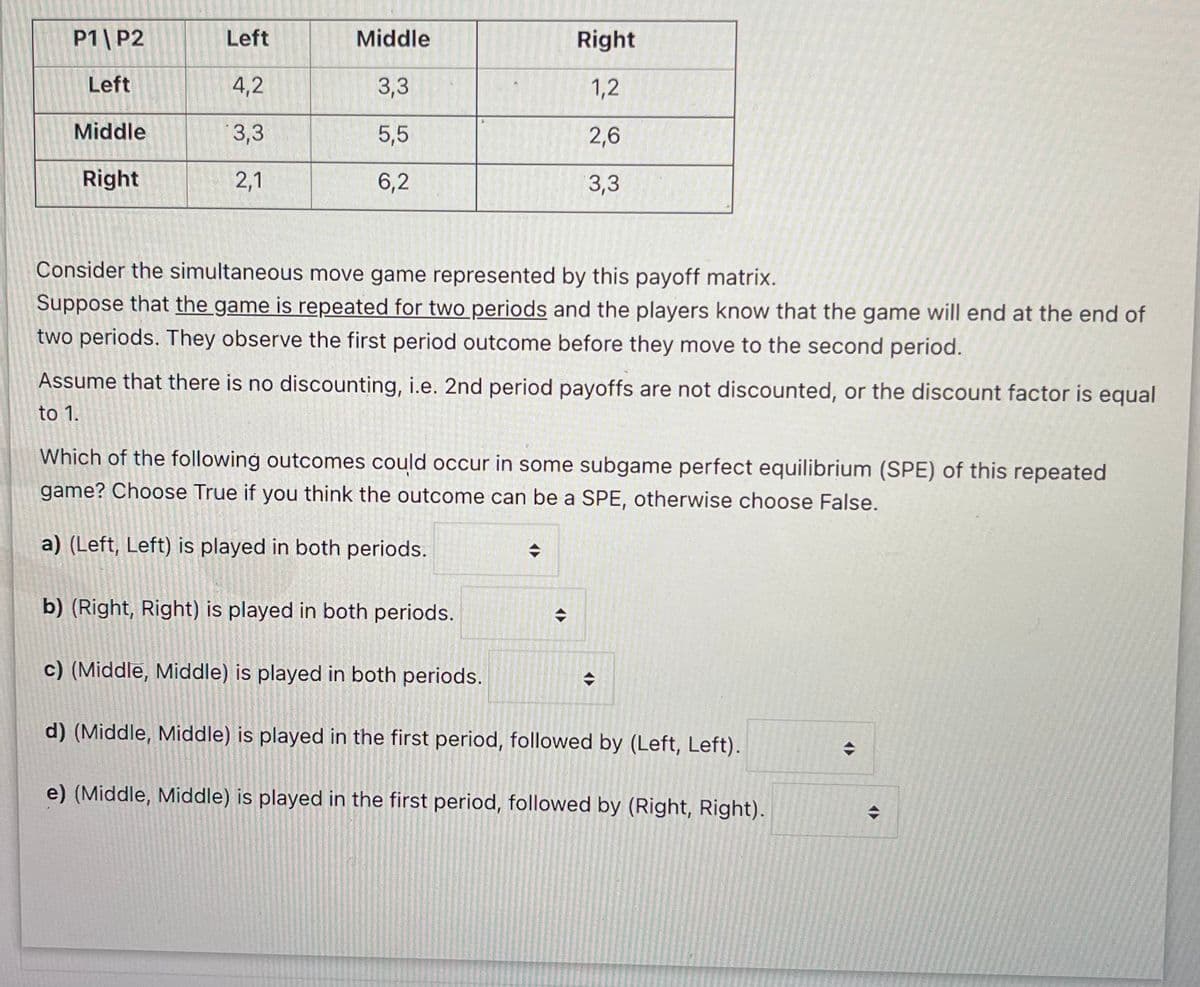P1| P2 Left Middle Right Left 4,2 3,3 1,2 Middle 3,3 5,5 2,6 Right 2,1 6,2 3,3 Consider the simultaneous move game represented by this payoff matrix. Suppose that the game is repeated for two periods and the players know that the game will end at the end of two periods. They observe the first period outcome before they move to the second period. Assume that there is no discounting, i.e. 2nd period payoffs are not discounted, or the discount factor is equa to 1. Which of the following outcomes could occur in some subgame perfect equilibrium (SPE) of this repeated game? Choose True if you think the outcome can be a SPE, otherwise choose False. a) (Left, Left) is played in both periods. b) (Right, Right) is played in both periods. c) (Middle, Middle) is played in both periods. d) (Middle, Middle) is played in the first period, followed by (Left, Left). e) (Middle, Middle) is played in the first period, followed by (Right, Right).
P1| P2 Left Middle Right Left 4,2 3,3 1,2 Middle 3,3 5,5 2,6 Right 2,1 6,2 3,3 Consider the simultaneous move game represented by this payoff matrix. Suppose that the game is repeated for two periods and the players know that the game will end at the end of two periods. They observe the first period outcome before they move to the second period. Assume that there is no discounting, i.e. 2nd period payoffs are not discounted, or the discount factor is equa to 1. Which of the following outcomes could occur in some subgame perfect equilibrium (SPE) of this repeated game? Choose True if you think the outcome can be a SPE, otherwise choose False. a) (Left, Left) is played in both periods. b) (Right, Right) is played in both periods. c) (Middle, Middle) is played in both periods. d) (Middle, Middle) is played in the first period, followed by (Left, Left). e) (Middle, Middle) is played in the first period, followed by (Right, Right).
Chapter7: Uncertainty
Section: Chapter Questions
Problem 7.7P
Related questions
Question

Transcribed Image Text:P1| P2
Left
Middle
Right
Left
4,2
3,3
1,2
Middle
3,3
5,5
2,6
Right
2,1
6,2
3,3
Consider the simultaneous move game represented by this payoff matrix.
Suppose that the game is repeated for two periods and the players know that the game will end at the end of
two periods. They observe the first period outcome before they move to the second period.
Assume that there is no discounting, i.e. 2nd period payoffs are not discounted, or the discount factor is equal
to 1.
Which of the following outcomes could occur in some subgame perfect equilibrium (SPE) of this repeated
game? Choose True if you think the outcome can be a SPE, otherwise choose False.
a) (Left, Left) is played in both periods.
b) (Right, Right) is played in both periods.
c) (Middle, Middle) is played in both periods.
d) (Middle, Middle) is played in the first period, followed by (Left, Left).
e) (Middle, Middle) is played in the first period, followed by (Right, Right).
Expert Solution
This question has been solved!
Explore an expertly crafted, step-by-step solution for a thorough understanding of key concepts.
This is a popular solution!
Trending now
This is a popular solution!
Step by step
Solved in 2 steps with 1 images

Knowledge Booster
Learn more about
Need a deep-dive on the concept behind this application? Look no further. Learn more about this topic, economics and related others by exploring similar questions and additional content below.Recommended textbooks for you

